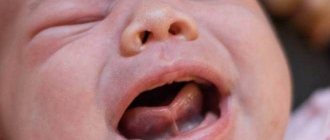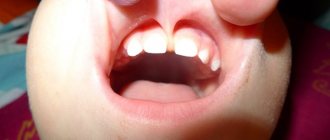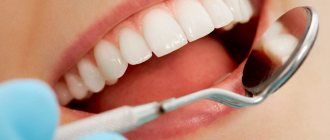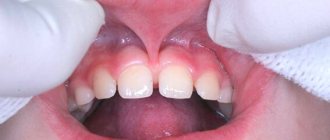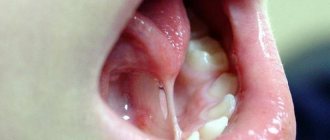If your child speaks poorly or you notice obvious signs of malocclusion in your baby, you should go for a consultation with a pediatric dentist. You can get rid of these and other problems with a simple procedure - you need to correct a short frenulum of the tongue in a child.
The frenulum of the tongue is a bridge that connects the tongue and the lower palate. It is responsible for how the tongue functions, affects speech, the ability to drink and eat, and swallow. The condition of the frenulum even affects the breathing process!
Here there is the possibility of pathology consisting in insufficient length, which leads to the recommendation to trim the frenulum of the child’s tongue. Why is it needed?
Let's consider the reasons for the need for this operation for children from a very early age. For newborn babies, sucking is a vital function. It is she who suffers in case of frenulum pathology. If it is not trimmed, the baby will not be able to drink mother's milk, including from a bottle with a nipple. It must be said that surgery in early childhood is easier to tolerate than in adulthood, so parents should not worry about the baby’s well-being.
Further, if a short frenulum of the tongue is detected at an older age, doctors advise surgery to prevent the defect from affecting the formation of the bite, and to avoid speech problems and disturbances in the process of eating.
What is lingual frenuloplasty?
The frenulum is a small membrane that connects the lower part of the tongue and the mucous membrane of the lower jaw. Despite its small size, it performs very important functions: it is responsible for the formation of dental occlusion, controls the mobility of the tongue and the functioning of the facial muscles.
There are three main pathologies of the tongue frenulum that require surgical correction.
- Wrong shape.
A healthy frenulum is a fold of mucous membrane in the shape of an arc. - Small size
(in medical terminology - ankyloglossia). The average length of the frenulum of the tongue in an adult is 3 centimeters; in a child it is shorter. In the case of ankyloglossia, the frenulum will not allow the tongue to be raised completely upward. - Incorrect mounting location.
A healthy frenulum is attached to the middle of the tongue, and with pathology it can be shifted to the tip.
In some cases, it becomes necessary to perform plastic surgery of the lip frenulum - the fold of mucous membrane connecting the lip and gum. The operation is performed to avoid impaired diction and the formation of malocclusion. Read more about lip frenuloplasty here.
How to correct a short frenulum of the tongue?
Let's consider a surgical method to solve the problem. How to correct a short frenulum of the tongue? There is a scalpel method and laser surgery. The first involves mechanical incision (in one of several options) and suturing of the ligament if necessary. All this takes place under local anesthesia. The operation takes on average 30 minutes.
Frenumplasty can be performed in different ways. It is possible to make incisions to the ligament followed by sutures in the lower and upper parts, incisions on the sides, as well as moving the attachment site of the ligament.
The recovery period lasts about a week. At this time, swelling and slight pain may occur. After 10 days, the stitches will begin to dissolve. During recovery, care must be taken when eating, and the baby's parents should monitor this. In addition, the dentist may recommend rinsing the mouth with a special solution or using healing medications.
Causes of tongue frenulum anomaly
Most children have mild pathology, but severe forms are also not uncommon. The size of a child’s tongue frenulum is most often determined by heredity, as well as the following factors:
- viral infection in the mother in the first and last trimesters;
- late toxicosis;
- exacerbation of chronic diseases during pregnancy;
- injuries in the abdominal area during gestation;
- taking potent drugs by the expectant mother.
Why frenulum abnormalities require seeing a doctor
Abnormalities of the labial frenulum
Such a frenulum (either short or long) leads to the fact that the front teeth move apart and a gap forms between them - a diastema. In addition, over time, gum recession occurs and tooth roots become exposed. This is dangerous because teeth become more sensitive and the risk of caries increases.
Anomalies of the frenulum of the tongue
- feeding difficulties: immediately after birth, the baby experiences difficulties, he has to make Herculean efforts to suck breast milk or a bottle of formula. Discomfort makes the baby refuse to eat, the baby becomes very capricious, and loses weight. This is due to the fact that the sucking reflex is impaired, since the tongue is limited in movement,
- Digestive problems: difficulty eating and swallowing leads to diseases of the gastrointestinal tract,
- developmental delay: such a child takes longer to gain weight than healthy ones and grows worse. Not receiving the vitamins and substances the body needs, it begins to lag behind its peers,
- articulation disorder: the voice becomes hissing or whistling, a lisp appears. The change in diction is explained by the fact that the child cannot pronounce certain sounds normally - again due to limited tongue movement,
- the development and proper functioning of the entire maxillofacial apparatus is disrupted.
Most often, a violation of the structure of the frenulum is a congenital pathology; there is also a high probability of the pathology being transmitted by inheritance - studies note1 that parents who suffered from this disease in childhood had beloved children who were also susceptible to a similar anomaly. But in some cases, the reason lies in the occurrence of problems during pregnancy: these could be frequent stressful situations, a lack of vitamins, or untreated infections in the baby’s mother.
Symptoms of a shortened frenulum
How to determine if your baby needs surgery? It is necessary to seek specialist advice. However, you can notice signs of a defect in the frenulum of the tongue yourself by paying attention to some details.
- The frenulum resembles a transparent film and does not have a vascular network.
- The tongue is inactive.
- The child cannot reach the upper palate with the tip of his tongue.
- When you move your tongue, clicks are heard.
- Chewing and swallowing are difficult.
- Diction is broken.
- The lower front teeth are turned towards the tongue.
Laser plastic surgery of lip and tongue frenulum: main advantages
- Versatility. The operation can be performed on children and adults.
- No pain. If necessary, a special anesthetic gel is used.
- High efficiency of the procedure. The intervention only takes 2-3 minutes to complete.
- Minimal trauma. During surgery to shorten the frenulum of the tongue or lip with a laser, there is virtually no bleeding in children and adults. Recovery takes only a few days.
- No risk of wound infection. During laser exposure, the vessels of the tongue or lips are sealed. In addition, the beam itself has a disinfecting effect. It affects pathogenic bacteria, destroying them.
When and who needs tongue frenuloplasty?
Most often, an abnormality of the frenulum of the tongue can be diagnosed in a child immediately after birth. Then it is recommended to fix it. However, plastic surgery is performed on children of preschool and school age, as well as adults. The operation is indicated in the following cases.
- Violation of sucking in newborns.
If babies have a tongue frenulum that is too short, they cannot latch onto the nipple properly, resulting in underweight, fussiness, and poor sleep. - Diction defects.
Due to poor tongue mobility, children distort some sounds, especially “r”, “l” and hissing sounds. As a rule, the problem is discovered by a speech therapist in preschool age. - Abnormal shape of teeth and gums.
A tongue frenulum that is too short can interfere with proper growth of the lower jaw. This leads to incorrect positioning of the front teeth and gum recession. - Preparation for implantation and prosthetics.
Any deviations in the shape of the soft tissue from the norm can ultimately lead to implant failure, so they need to be corrected before surgery. The discomfort caused by the pathology of the frenulum of the tongue during the use of removable dentures, especially on the lower jaw, is also important: the structures simply fall out when talking or eating.
Indications for surgery
Abnormal frenulum length is corrected surgically. Surgery at an early age is indicated in the following cases:
- when the baby has difficulty sucking the breast;
- when a child begins to develop an abnormal bite;
- when a displacement of the dentition occurs in the baby’s oral cavity;
- even if the speech therapist cannot help the child correct speech defects.
Up to a year, the frenulum is cut with scissors and stitches are applied if necessary. The operation is performed quickly and painlessly, since there are no nerve endings in the frenulum.
Preschoolers and children of primary school age also have their frenulum cut, but a little differently. The frenulum is cut with a special scalpel, and the attachment site is moved to another place and sutures are applied.
Teenagers' bridles are not cut. A speech therapist works with them, and the dentist prescribes special exercises to stretch the frenulum.
Correction of the frenulum can also be indicated for patients in adulthood (at one of the stages of orthopedic treatment).
What happens if tongue frenuloplasty is not performed in children?
An abnormality of the frenulum of the tongue in children provokes the following serious consequences.
- Due to a violation of the sucking regime in infancy, the child may not receive enough nutrition and, as a result, lag behind in development.
- Children with tongue frenulum abnormalities may never learn to pronounce some sounds.
- Incorrect placement of the frenulum leads to underdevelopment of the lower jaw, resulting in the formation of an incorrect bite.
If pathology of the frenulum of the tongue has been identified in a newborn, it can be easily corrected by making an incision with a laser. At this age, you won't even need stitches. With age, the structure of the frenulum becomes more complex, new vessels appear in it, so plastic surgery of the frenulum in preschool and school-age children turns into a full-fledged surgical operation. Therefore, it is best to do it at the age of 5-6 years, when the child’s milk teeth are replaced by permanent ones.
Parents can determine whether their child needs surgery on their own. To do this, ask him to reach the upper palate with the tip of his tongue. If he cannot do this, or it hurts, he should consult a doctor.
Features of the procedure
Plastic surgery of the frenulum of the tongue involves cutting it with a scalpel or surgical scissors. After cutting the fold of the mucous membrane in a newborn, the tissue immediately stretches and lengthens after healing. When the operation is performed at the age of 3–5 years, the process of stretching the frenulum is more complex. To increase the length of the fold and prevent the formation of scars, the child will need to perform special exercises.
In Martinka dentistry, plastic surgery of the frenulum of the tongue and lip is performed not only by the classical, but also by the modern method using a laser. The use of laser equipment eliminates the risk of infection and bleeding. The laser has an antiseptic effect and instantly seals the vessels; moreover, during the operation there is no contact of the instrument with the tissues of the oral cavity. Laser surgery involves contraindications and is only allowed for children over 1 year of age.
For newborn children, tongue frenuloplasty can be performed without anesthesia. In children from 3 months of age, the folds of the mucous membrane thicken, which suggests discomfort and minor pain during the operation, so cutting the frenulum is done with local anesthesia. Sedation is used only in extreme cases, if the child has complex illnesses or increased anxiety.
Operation techniques
There are two methods of performing tongue frenuloplasty: traditional (classical) and laser. This is a more modern and safer method. The laser allows the operation to be performed with great precision and does not cause bleeding after the procedure. In addition, there is no need for stitches, and healing time is significantly reduced. This is especially important if you need to perform laser frenuloplasty on a child: the baby will tolerate the procedure much easier.
Depending on what pathology of the frenulum is detected, the doctor uses one of three techniques: cuts the frenulum, removes it, or changes the attachment site. The number of cuts and their shape depend on the choice of technique.
Stages of the procedure
Trimming a short frenulum, despite the lack of complexity of the procedure, should be performed by a qualified specialist and in a medical facility. Patients do not require hospitalization. The operation takes no more than 10 minutes. Immediately after completion of the plastic surgery, the child is sent home. It is not recommended to feed the baby in the first two hours. Young children are allowed to drink water.
Stages of plastic surgery of the frenulum of the tongue.
- Preparation. The doctor asks parents for complaints, performs an examination and, if necessary, gives recommendations on preparation for the procedure.
- Operation. Administration of anesthesia, antiseptic treatment of the oral cavity, trimming of the frenulum.
In newborns, the integrity of the mucous membrane is restored in 1–3 days. The child may be restless on the first day. Difficulties with feeding cannot be ruled out, but already on the second day, babies begin to correctly take the breast or bottle nipple, which caused difficulties previously. Parents are advised to give the baby water after each feeding to avoid the accumulation of formula or milk in the mouth and the subsequent development of infection. Also, the mother must maintain breast hygiene and sterilize bottles.
Therapeutic exercises
There are alternative methods that allow you to do without surgery, for example, a set of special exercises for developing the frenulum of the tongue.
- Reach alternately to the upper and lower lips.
- Extend your tongue and make pendulum movements from cheek to cheek.
- Suck your tongue to the roof of your mouth and let go, imitating a horse clopping its hooves.
- Place your tongue on each cheek with your mouth closed.
- Smile with your mouth open.
- Stretch your lips.
- Pull your lips into a tube, pretending to kiss.
To achieve results, you need to perform the exercises every day for 5 - 10 minutes. It is important to remember that this method is suitable for correcting mild disorders; more severe pathologies require surgical intervention.
Consultation with a speech therapist “How to stretch the hyoid frenulum?”
Natalia Khryakova
Consultation with a speech therapist “How to stretch the hyoid frenulum?”
The hyoid frenulum is a membrane that connects the tissues of the floor of the mouth and the tongue.
A short hyoid frenulum is located too close to the tip of the tongue and limits upward movement of the tongue.
Description and rules for performing exercises for the hyoid frenulum .
Exercises to stretch the hyoid frenulum are performed as often as possible, up to 5-7 times a day for 10-15 minutes. Be sure to check that the exercises are performed correctly in front of a mirror.
According to the recommendations, the basic rules for conducting articulation exercises include:
• slowness, lack of haste and maximum impact;
• good mood, smile and wide open mouth;
• it is necessary to alternate between exercise and rest, because such activities are serious physical activity.
Attention! If the child has undergone surgery to trim the hyoid ligament , then the given exercises must be performed for stretching and development, since it happens that the frenulum grows together and the situation becomes worse than it was before the operation. The child also needs to be seen by an orthodontist or dentist. It must be remembered that exercises can only be performed under the supervision of a speech therapist .
A set of exercises for stretching the hyoid ligament ( " frenulum "
).
"Chicks"
The mouth is wide open, the tongue lies quietly in the oral cavity.
"Spatula"
The mouth is open, a wide, relaxed tongue rests on the lower lip.
"Needle"
Open your mouth. Stick your tongue far forward, tense it, make it narrow. Hold in this position for up to 15 seconds.
"Tube"
The mouth is open, the lateral edges of the tongue are curved upward.
"Watch"
The mouth is open. Lips are stretched in a smile . The tip of the narrow tongue alternately stretches at the teacher’s count to the corners of the lips.
"Swing"
1. Smile, open your mouth. On the count of "one-two"
alternately rest your tongue on the upper and lower teeth. The lower jaw is motionless.
2. Smile, open your mouth, reach with the tip of your tongue first to your nose, and then to your chin, then again to your nose, and then again to your chin.
"Football"
Close your mouth, press the tip of your tongue with tension into one or the other cheek.
"Delicious jam"
The lips are stretched into a wide smile , so that all the teeth are visible. The lower jaw is lowered, the distance between the teeth is 1-1.5 fingers. The tongue lies quietly in the oral cavity.
Without changing the position of the lips and lower jaw, stick out the wide tongue forward, bend its wide tip upward, covering the upper lip with it. Then we remove the tongue into the oral cavity, as if licking the upper lip from top to bottom. A child can, in fact, smear jam or honey on his upper lip.
Attention! The tongue moves strictly in the up-down direction. The lips and lower jaw should be motionless during the exercise.
"Painter"
The lips are stretched into a wide smile , so that all the teeth are visible. The lower jaw is lowered, the distance between the teeth is 1-1.5 fingers. The wide tip of the tongue rests against the base of the upper incisors, the lateral edges of the tongue are pressed against the base of the molars.
The wide tip of the tongue moves as far as possible into the depths of the mouth, without leaving the upper palate, as if stroking it, and returns back in the same way.
Attention! Make sure that the lower jaw is motionless and does not move forward.
“Brushing the upper teeth”
Smile so that both the upper and lower teeth are visible; Open your mouth wider. The chin is motionless! Use the tip of your tongue to vigorously rub the tubercles behind your upper teeth from side to side from the inside.
"Drum"
The lips are stretched into a wide smile , so that all the teeth are visible. The lower jaw is lowered, the distance between the teeth is 1.5 fingers. The wide tip of the tongue rests on the base of the upper incisors.
We pronounce sounds: “d-d-d”
at a fast and slow pace.
Attention! Only the tip of the tongue works, the lower jaw and lips are motionless.
"Horse"
The lips are stretched in a wide smile , so that all the teeth are visible. The lower jaw is lowered, the distance between the teeth is 1.5 fingers. The wide tip of the tongue rests on the base of the upper incisors. The anterior part of the back of the tongue is tightly pressed to the upper alveoli. The lateral edges of the tongue are pressed against the base of the molars.
We forcefully tear the tongue away from the teeth and palate and lower it down. The exercise can be performed at a fast or slow pace.
Attention! The lower jaw continues to remain motionless.
"Fungus"
The lips are stretched into a wide smile , so that all the teeth are visible. The lower jaw is lowered, the distance between the teeth is 1-1.5 fingers. The wide tip of the tongue rests on the base of the upper incisors. The anterior part of the back of the tongue is tightly pressed to the upper alveoli. The lateral edges of the tongue are pressed against the base of the molars. In the gap between the upper and lower teeth, you can see the body of the tongue, resembling a mushroom cap, and a stretched hyoid ligament , reminiscent of its stem.
We hold this position for as long as possible, ideally up to 10 seconds.
Attention! The lower jaw remains strictly motionless.
"Harmonic"
The lips are stretched into a wide smile , so that all the teeth are visible. The lower jaw is lowered, the distance between the teeth is 1-1.5 fingers. The wide tip of the tongue rests on the base of the upper incisors. The anterior part of the back of the tongue is tightly pressed to the upper alveoli. The lateral edges of the tongue are pressed against the base of the molars.
Now we slowly lower the lower jaw until it is possible to hold the tongue in place, pressed to the palate. Feel how “ frenulum ”
?
Now we just as slowly return the lower jaw to its original position. The exercise is performed first at a slow, then at an increasingly faster pace. The hyoid ligament stretches and contracts like the bellows of an accordion.
Attention! During the exercise, the lower jaw falls straight down, without moving forward or moving to the side.
"Household"
exercises to
stretch the hyoid ligament :
1. Licking plates from shallow to deep.
2. Eat ice cream by licking it with your tongue.
3. Licking jam from a large tablespoon with your tongue (yogurt, honey, condensed milk, etc.)
4. Licking a large Chupa Chups
and so on.
Price for plastic frenulum of the tongue
The cost of this procedure usually consists of the cost of consultation and examination, local anesthesia and the service itself. This is a fairly simple surgical procedure, so no additional tests are required. The price of a classic operation (with a scalpel) for adults and children is the same, but may be slightly higher if the patient has too dense frenulum tissue. Then they do not give local anesthesia, but general anesthesia; it costs more, and, accordingly, costs increase due to this. The average cost of classic lingual frenuloplasty in Moscow is 3,800 rubles. The price for laser plastic surgery of the frenulum of the tongue is about 5,000 rubles.
Indications and contraindications for frenulum correction
The following are considered good reasons to undergo frenuloplasty:
- inability to breastfeed;
- the presence of a wide, shortened frenulum, its splitting;
- inflammatory processes of the periodontium due to incorrect position of the tongue, caries, bite pathology due to a short frenulum;
- sound pronunciation defects in children that cannot be eliminated conservatively;
- preparation for orthodontic and orthopedic dental procedures.
In adults, the most common reason for frenuloplasty is periodontal disease, although it happens that a lisp, not eliminated in childhood, brings an adult patient to the surgeon.
In each case, indications for tongue frenuloplasty are assessed individually, taking into account the patient’s age and symptoms. If you refuse treatment when it is really needed, an abnormal frenulum will lead to bite defects, burr, and provoke caries and periodontal inflammation.
Tongue frenuloplasty cannot be performed if:
- acute infectious diseases of a general nature (respiratory viral, intestinal infections, etc.);
- blood clotting pathologies;
- malignant tumors;
- acute inflammatory changes in the mouth;
- systemic connective tissue diseases;
- acute caries;
- mental illnesses.
The timing of surgery in children is a controversial issue. Many experts prefer to do it to newborn babies who have not left the walls of the maternity hospital, citing the fact that immediately after birth, the mucous fold under the tongue has little blood supply and is devoid of nerve endings, which means that the manipulation will be low-traumatic and painless. In addition, the newborn will certainly not remember what happened and will not experience psychological trauma, which may well occur if the child is already 6-7 years old and he is naturally afraid of any medical procedures. If the frenulum was not cut in the maternity hospital, but in the process problems arise with feeding in the first year of life, the pediatrician will advise you to consult a surgeon, who can refer you for plastic surgery in the first months of life. In cases where signs of an abnormally short frenulum make themselves felt in older children during the formation of speech and pronunciation of sounds, experts prefer not to rush, paying maximum attention to conservative measures (exercises, classes with a speech therapist). Only if conservative treatment is ineffective and there are persistent speech therapy problems, the frenulum will be dissected before school. For adults with frenulum anomalies, there is no age limit for the operation. If pathology interferes with normal life activities, there is caries, problems with the pronunciation of certain sounds, then there is no point in postponing intervention.
